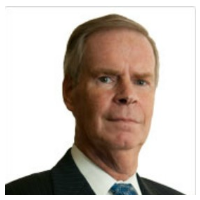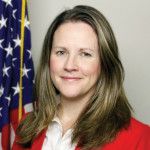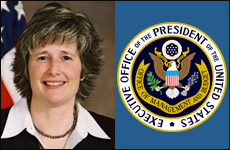 Exclusive
Exclusive New playbook, catalog seek to change shared services’ history of ineffectiveness
Beth Angerman, the executive director of the Unified Shared Services Management (USSM) Office, said the modernization and migration management (M3) framework, a...

Agencies may finally have a path to get over the long-standing struggle to modernize and consolidate back-office systems.
A new framework and playbook give financial management, human resources, grants and other executives a step-by-step process to move to a shared services provider.
Beth Angerman, the executive director of the Unified Shared Services Management Office, said the modernization and migration management (M3) framework goes through six phases starting with assessment and ending with operations.
“At the recommendation of several authoritative bodies, including the Government Accountability Office, the Office of Management and Budget and others, there was a recommendation to create a best practice process, leveraging lessons learned, project management disciplines that would help agencies improve the likelihood of success for these types of implementations,” Angerman said in an interview with Federal News Radio.
“We’ve learned a lot over the last few years, especially with the Department of Housing and Urban Development migration to Treasury’s Administrative Resource Center for financial management and human resources. We are learning a lot with Homeland Security Department and their migration to the Interior Business Center. All of those lessons learned are helping us to craft this best practice playbook, which is a series of steps, processes, templates, documents and good best practices that will help agencies plan what success looks like, what they are actually looking to migrate to a shared service, how they are going to adopt a standard offering at the shared service center and change their business processes to benefit from that standard offering, and then ultimately, what their retained organization is going to look like.”
Basically, the goal of the playbook, framework and a host of other new initiatives is to ease the pain of moving to a shared service provider for back-office systems.
The history of federal IT is filled with failed financial management modernization projects, whether it was the Labor Department and the Small Business Administration’s attempt to move to financial management providers in the private sector, or DHS’ numerous attempts to modernize on its own, time and again, agencies and vendors have struggled to change business practices or written poor contracts or just plain did a poor job managing the effort.
OMB estimated in 2010 that agencies are spending about $3 billion a year on financial management systems, many of which are running out-of-date technology.
These are among the reasons OMB created the USSM to act as a convener and collaborator to usher these projects through the arduous process.
Angerman said the new documents are for federal providers and customers as well as industry to better conceptualize how to do everything from deciding on what shared service makes the most sense to what is the business outcome of the effort to understanding the cost and capabilities trade off.
“The theme that is most prevalent in the playbook that comes from those lessons learned from HUD and DHS would be the theme around change management and customer planning. It goes back to understanding what it is you are actually looking to buy from your shared service provider, what services they are actually going to perform for you and understanding what the impact of that standard offering is going to be on your retained organization,” Angerman said. “The truth of the matter is the technology tends not to be the biggest problem with these implementations. The challenges are more around how you can get people and teams and management to understand the vision of what the organization is actually going to look like and how the organization is going to be reformed based on the use of a shared service provider.”
She said there is a lot of emphasis to get agencies to think about all of these things upfront so they have a conceptual idea before they get started and can adjust as needed.
USSM rolls out shared services catalog
Along with the framework and playbook, USSM is rolling out a new shared services catalog, and is just beginning to create standard service level agreements (SLAs) for customer agencies and providers.
Angerman said USSM started work on the standard SLAs about three months ago because, in part, it was dependent on finalizing the playbook and framework.
“We wanted to identify the key steps in the process that actually would require standards service level agreements. Starting at about phase 2 and going all the way through phase 5, each phase requires its own unique SLA because the relationship between the customer and provider is different in each phase,” she said. “We actually decided — based on the customer survey that we did — the first one that we did across the ecosystem of both FM and HR customers. The one thing we heard consistently from the customers we surveyed through the Customer Council and anecdotally through outreach efforts, is that there are still concerns about service level agreements, the negotiability of those and whether or not we have the right metrics in place.”
USSM is collecting existing SLAs and metrics that will eventually become the standard agreements and metrics.
Related Stories
“The base of all what we do start with the consistent definition of the functions, sub-functions and activities within each one of these administrative areas so we are talking things the same way, using the same common language and ultimately measuring the timeliness, the quality and the efficiency of those different activities in a consistent way,” Angerman said. “We are starting with phase 5 in the playbook because the operations and maintenance SLA seems to be to be the one we’ve heard the most feedback on.”
Additionally, USSM’s oversight process is gaining momentum through its customer, provider and governance councils, and just this summer started conducting ProviderStat reviews of all federal shared service providers. Angerman said the USSM office completed six of nine ProviderStats so far.
“We are addressing performance metrics, governance, the services they plan to offer that they don’t have today, challenges with funding, challenges in their home agencies and really anything else that would impact their success,” Angerman said at the Aug. 22 shared services industry day in Washington.
“What we learned is we think about shared services as four financial management providers, but we had 10 agencies reply to our data call. That helps us understand what our ecosystem is. We compiled a list of 260 functions across five administrative areas. There are only two that aren’t offered by more than one agency today. We learned all providers do use contractors, and everyone leverages employment of feds outside the Washington, D.C. area,” Angerman said. “We collected over 400 metrics, and 350 of them were somewhat unique, but the timeliness metric was most reported and most valued. Compliance is a key priority for government, and it’s framed around timeliness. And then quality and cost were the next most common ones, but they were far behind timeliness in the metrics.”
Shared services catalog similar to OMB’s Uncle Sam’s List
The IT shared services catalog builds on a similar effort led by the Office of Management and Budget in 2013 called Uncle Sam’s List.
Angerman said data call from the federal SSPs provided some surprising information.
“We ended up with a list of over 260 activities that the providers do and we’ve worked hard with the managing partners to come to common definitions so we can start talking about things the same way,” she said. “Now have a list that customer agencies can go to and analyze to make decision about what shared services to use. People say they don’t know who they can go to for shared services, so for first time we have the data to help inform customers and make it transparent to industry.”
The catalog should be available publicly later this fall.
Angerman said several agencies already are starting to use the playbook, some at the beginning and others jumping into the middle phases of the framework.
In all, about 20 agencies, including the Veterans Affairs Department, are in the process of moving to or considering a move to a shared service provider.
“We are bringing together stakeholders who all have a vested interest in how these administrative functions operate and how shared services can help deliver these types of services in a more efficient way,” Angerman said. “These may seem like little wins, but I actually think they are pretty significant because we’ve doing shared services for so many years in the government to finally have a catalog that tells everybody who does what and start to talk about things in a common way is a pretty significant step.”
Copyright © 2024 Federal News Network. All rights reserved. This website is not intended for users located within the European Economic Area.
Jason Miller is executive editor of Federal News Network and directs news coverage on the people, policy and programs of the federal government.
Follow @jmillerWFED






